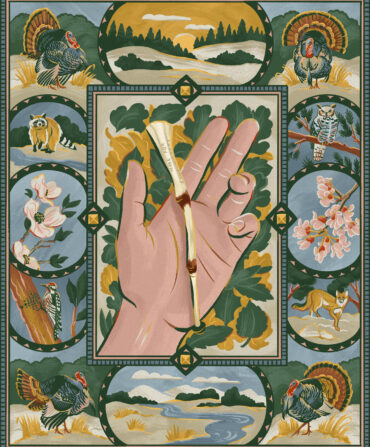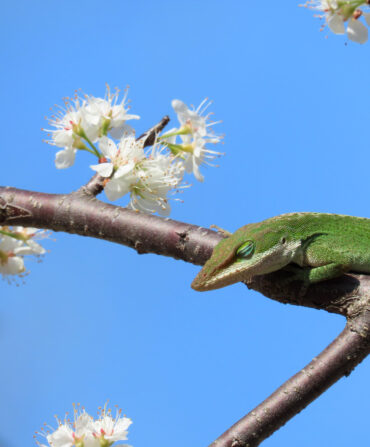Land & Conservation
The Enduring Magic of the Angel Oak
A beloved gathering spot and an emblem of resilience during the civil rights movement, this ancient South Carolina live oak is poised for an exciting future
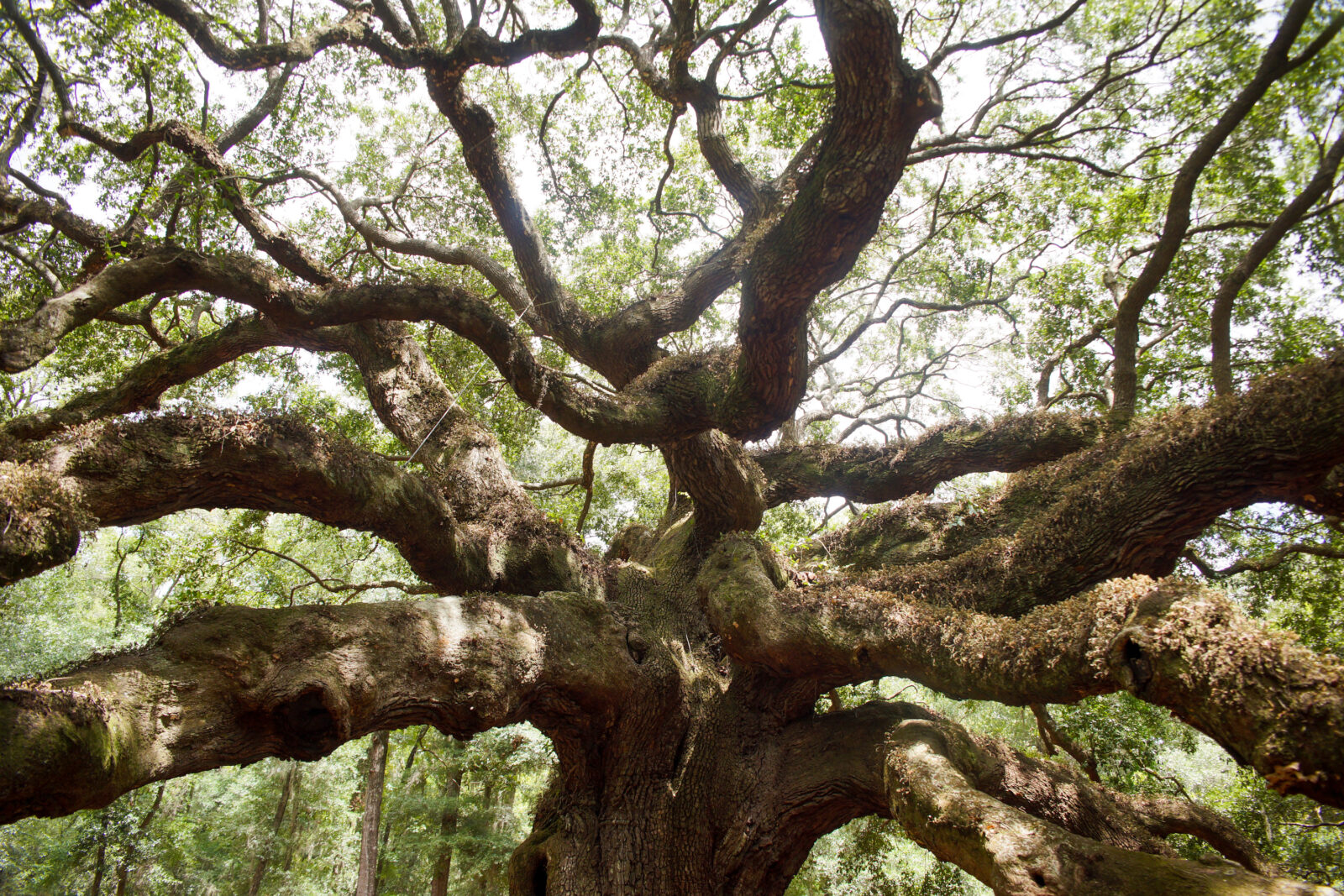
Photo: Courtesy of Lowcountry Land Trust
The Angel Oak on Johns Island, South Carolina.
As a student at the College of Charleston in South Carolina, Samantha Siegel drove almost every day to Johns Island to sit beneath the Angel Oak—a giant, ancient live oak whose impossibly arching branches are a testament to many hundreds of years of care and growth. “It was my sanctuary,” she remembers. “I could touch the tree and feel the negative energy drain from my body.” Then in 2008, she saw a small paragraph in Charleston’s Post and Courier: A developer had purchased the land surrounding the tree, and the City Council had approved plans for a complex called the Angel Oak Village. “The notice was buried in the back of the newspaper, and I just couldn’t believe it. I thought, ‘Why doesn’t everyone know about this?’”

Outraged, she told anyone who would listen: The development would clear thirty-five acres of maritime forest around the tree and construct more than six hundred townhomes and apartments, plus 40,000 square feet of retail space. Siegel gathered other community members and groups who feared for the tree’s health amid such development, founded a nonprofit called Save the Angel Oak, and waded into a years-long battle. “We showed up at every opportunity there was for public input. We hired our own experts and hydrologists and arborists to counter the developers,” she says. “Losing was not an option. We were prepared to fight until the tree was safe.” The nonprofit teamed up with the Coastal Conservation League and the South Carolina Environmental Law Project and took the developer to court over a wetland permit. The developer eventually went bankrupt in the process, the bank foreclosed on the property, and the Lowcountry Land Trust—where Siegel now works—raised millions of dollars in record time to buy the surrounding thirty-five acres in 2014. “Knowing that we had protected the Angel Oak forever…it was the best day of my life,” she says.
Today, the tree and its small gift shop remain open to the public and receive some 400,000 visitors a year. And Siegel and the Lowcountry Land Trust, assisted by the acclaimed landscape architecture firm Nelson Byrd Woltz, are in the process of designing the Angel Oak Preserve, a forty-four-acre park with paths, boardwalks, and a visitor’s center. The renovation—set to be completed over the course of 2025—is intended to spread people out on the site, keep the surrounding ecosystem healthy, and educate visitors on the tree’s long history.

Photo: Courtesy of Lowcountry Land Trust
The Angel Oak stands sixty-five-feet high and shades an area of over 17,000 square feet.
The Angel Oak’s exact age is unknown. One estimate from 1986 dates it to 1,400 years old. Other arborists say it falls somewhere between 400 and 1,000 years old. But even before the oak first started to grow, the site appears to have been significant to the Coosaw people who inhabited the Lowcountry, possibly as a ceremonial site; archaeologists have discovered stone arrowheads, pipes, and pottery, some dated between 5,000 and 8,000 years ago. “It makes me think that this area was important even before the tree was there, and that maybe the tree was planted intentionally,” Siegel says.
In 1675, as reported in a 1910 article in South Carolina Historical and Genealogical Magazine, a man named Andrew Percivall traded a package of beads, cloth, and other goods to the Coosaw people in exchange for land rights along the Stono, Kiawah, and Edisto Rivers. Soon after, he granted much of Johns Island to an English acquaintance named Jacob Waight, who turned the land surrounding the Angel Oak into a plantation. By 1717, enslaved people toiled in fields of corn and cotton, tended livestock and machinery, and ran the household, and would for the next hundred and fifty years. Historians believe that some of their living quarters were near the growing oak.
The Angel family (a Waight daughter married a man named Justus Angel in 1810, officially giving the tree its name) remained the owners of the land following the Civil War, and historical records and personal testimonies indicate that the Angels continued to grow cotton there until 1904. After that, the family left the oak open to the public. “The tree is visited daily by tourists and by others in the vicinity, who go again and again to see the remarkable oak,” reports a 1931 newspaper article. The Angel Oak played host to picnics, celebrations, and church services. According to a 1980 oral history the South Carolina Historical Society conducted with the Charleston civil rights activist Septima Clark, it was a place anyone could gather. “Segregation was at its height, but the tree was not segregated,” she recalled. “We could go in and have our picnic lunch, spend the day, the children would play under the tree…”
Hear the late Septima Clark recall the reverence local residents had for the Angel Oak:
And soon, Johns Island—anchored by the Angel Oak—would become the heart of the Charleston civil rights movement. In 1948, two Johns Island residents, Esau Jenkins and Joe Williams, formed the Progressive Club to empower the island’s Black community through education. The club met monthly and eventually brought on Clark, who also lived on the island, to help open a Citizenship School to boost adult literacy in order to gain voting and other rights. The effort was so successful that Clark exported its model across the Jim Crow South. On Johns Island itself, the school grew into a community hub that included a grocery store with fuel pumps, and a multipurpose room that was used as a gymnasium, classroom, community center, daycare, and commercial kitchen. Twice, Martin Luther King, Jr. visited.
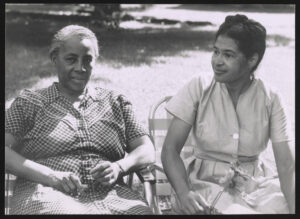
Photo: <a href="https://www.loc.gov/item/2015652115/" target="_blank">Retrieved from the Library of Congress, Prints and Photographs Division</a>
Septima Clark (left) and Rosa Parks at Highlander Folk School in Monteagle, Tennessee, in 1955.
The Angel Oak and all it stood for was well-known to the group of activists. In her oral history, Clark even recounts an alternate version of how the tree got its name:
The people on the island, they declared that angels would appear…they said that the tree was there during slavery times and the killings and things that happened around the tree, they could see them through the stars out there. People who were supposed to have had a caul, were born with a caul, in that way they could see things around that tree…then they considered that the angels brought these spirits there. So, that’s how they finally decided that Angel Oak was the name for this tree.
Clark remembered the tree held a special meaning to the Black community. “From the early days, I think, Black people told their children stories about that tree,” she recalled. “It was sacred, and it is sacred to them….This is the kind of thing that I think the people on the island still feel about the Angel Oak.”
Bill Saunders, a fellow Johns Island activist who was mentored by Esau Jenkins, remembered the tree as “a tower of strength” and a symbol of resilience in a 2016 oral history conducted by the Lowcountry Land Trust:
At one point [my grandmother] said to me, and it still lives with me today, she said, “Son, if you don’t lose that temper, you’re going to be just like the pine tree. When the wind and rain and storm come, you gonna snap off. Or you can be like Angel Oak, and when the wind and the rain and the storm come, you can just move with it, and when the storm is gone, you are majestic again—nobody even knew you went through something.” And that really was interesting stuff that stuck with me, and I’m eighty-one right now.
During the civil rights movement and into the 1980s, the tree also served as an important storytelling site for the Gullah Geechee people, descendants of West Africans once enslaved in the Lowcountry. (Gullah Geechee Nation immediately supported Siegel in her efforts in 2008.) Patricia Jones-Jackson, a scholar of Sea Island traditions, remembers one such storyteller in her book When Roots Die: Endangered Traditions of the Sea Islands. “Miss Myma always told the first tale at a preplanned storytelling as a way of sanctioning the event,” she writes. “The huge Angel Oak with its ghostly hanging moss shaded the ground so grass would not grow around it and thus helped provide a clean insect-free surface on which to relax. It also served as an anchor for Miss Myma’s friends as a place to sit, smoke, take a little nip, and catch the breeze throughout the day and into the night.”
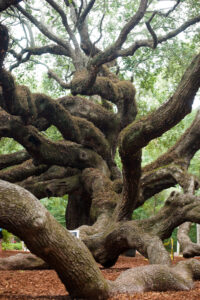
Photo: Courtesy of Lowcountry Land Trust
Visitors to the Angel Oak can walk beside its huge branches that stretch along the ground.
In 1991, the city bought the three acres the tree sits on and made it into a city park. The oak stands sixty-five-feet high, shading an area of over 17,000 square feet, surrounded by the acreage that Siegel and others fought to keep from development and that will soon become the Angel Oak Preserve. In the meantime, the state of South Carolina has endorsed a nomination for the tree to go on the National Historic Register.
“Someone has been conserving this tree since it was born,” Siegel says. “In order for it to have grown the way that it has, the surrounding trees would have had to be cleared to make room for it. Humans have been taking care of it back before Europeans were even on this continent, and I’m so grateful that we can experience its same magic today. Walking under its branches, I always wonder: What has it seen? Who else has walked around this trunk? Who else has loved this tree?”


